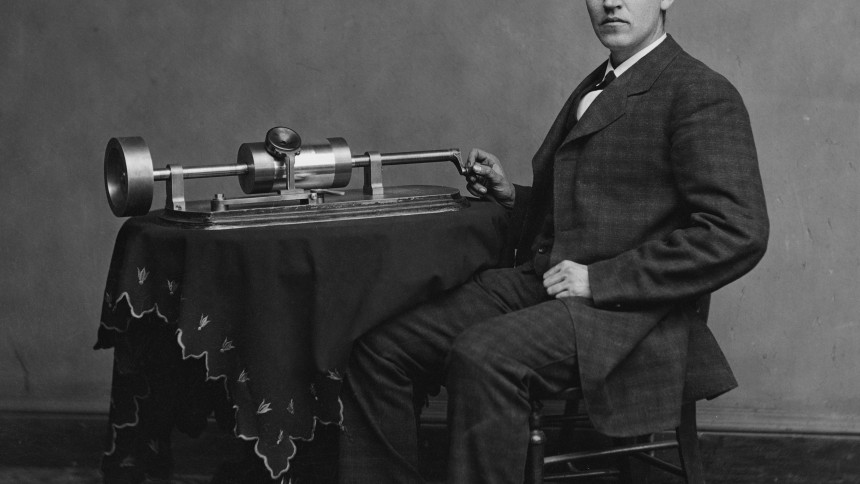New Jersey inventor Thomas Edison was working on a system to record telegraph messages on strips of waxed paper in mid-1877 when, by his account, he came to believe he could record the telephone the same way. Invented just a year earlier, the telephone converted sound waves into an electrical current that was just strong enough to energize a delicate electromagnet. By using the electromagnet to vibrate a steel stylus, Edison hoped to inscribe a record of the original sound wave into the wax. His idea was not simply to study the nature of recorded sound, but to reproduce the sound as well. That required a recorder that could also reproduce, or play back.
The telephone recorder didn’t really work very well (but the idea would become the basis of later “electrical” recordings). Instead, Edison developed his recorder/reproducer by more-or-less re-inventing the Cros Phonautograph, attaching a flexible membrane over the small end of a mouth-piece (labeled B above). A stylus attached to the membrane touched the surface of a moving recording “medium” (and he experimented with several). He eventually settled on a rotating cylinder rather than a moving strip of paper. Shouting into the mouth-piece Edison made the stylus vibrate, and touching the vibrating stylus to the moving recording medium resulted in a record of the sound in the form of a tiny groove.
Edison went a step beyond Cros in attempting to use the resulting recording in reverse– with the stylus resting in the groove, moving the recording medium should, he reasoned, cause the diaphragm to vibrate, recreating the original sound. The real innovations were in finding a recording medium that was soft enough to receive the recording, but sturdy enough so that when the recording process, and in finding a diaphragm that was supple enough to capture the delicate sound waves, but stiff enough to make noise then the recording was played. After numerous experiments, Edison (and he was joined by a team of outstanding co-inventors who rarely get the credit they deserve) settled on tinfoil as the recording medium, but adapted his machine to use one diaphragm/stylus combination for recording, and a second one, with slightly different materials, for reproducing the sound. His original patent drawings show the recording mouthpiece on the right and the reproducer on the left, with the cylinder (shown from the side) in the middle.
In July of 1877, Edison filed his first patent in Great Britain on a sound recording and reproduction of sound, and his American patents soon followed. A full specification for the phonograph was filed in April, 1878, about the time that he posed with the invention for the famous photographer Matthew Brady (above).
 During 1878, the first 600 or so tinfoil phonographs were made by several small machine shops at Edison’s request. These were distributed to demonstrate the principle of phonography. A German company licensed the patent rights and attempted to build a talking doll. The dolls did not work very well and most were returned by unhappy customers. Following this, Edison moved on to work on other projects and paid little attention to the phonograph for almost a decade.
During 1878, the first 600 or so tinfoil phonographs were made by several small machine shops at Edison’s request. These were distributed to demonstrate the principle of phonography. A German company licensed the patent rights and attempted to build a talking doll. The dolls did not work very well and most were returned by unhappy customers. Following this, Edison moved on to work on other projects and paid little attention to the phonograph for almost a decade.


